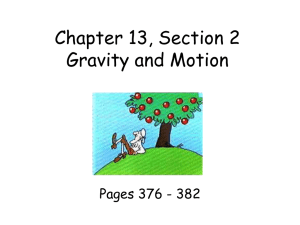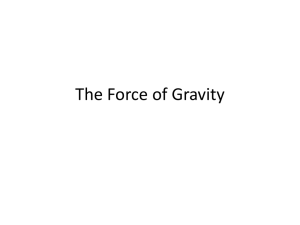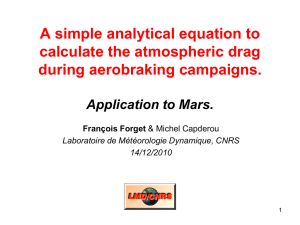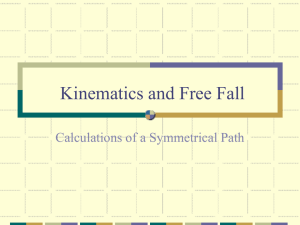Spacecraft Planetary Capture Using Gravity Assist
advertisement
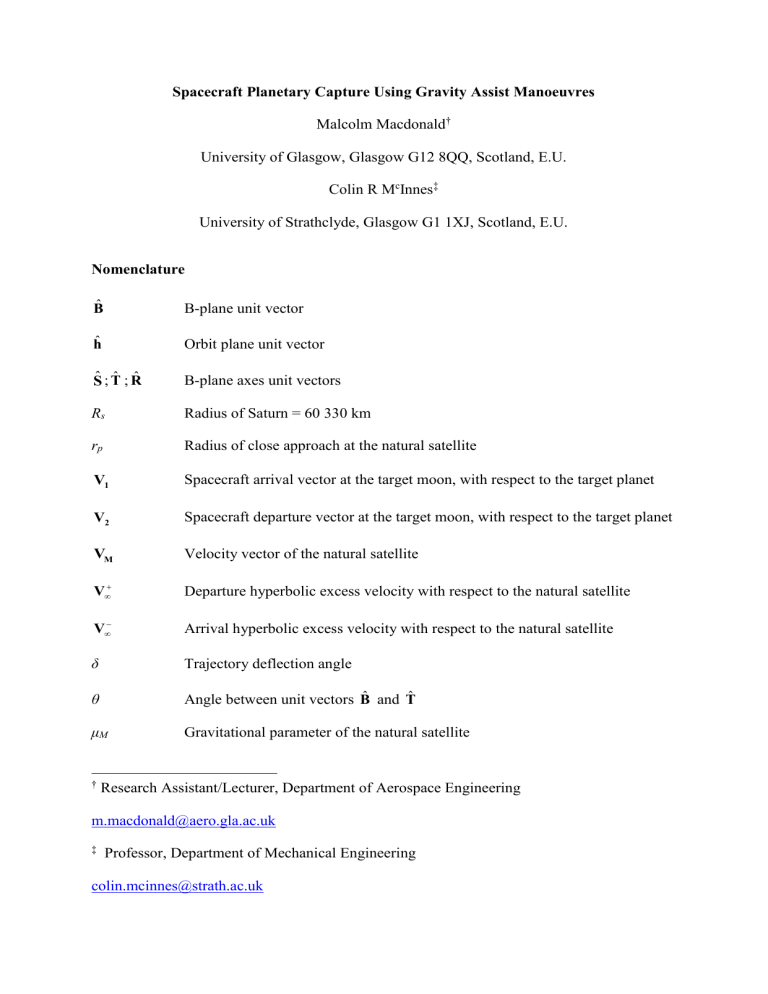
Spacecraft Planetary Capture Using Gravity Assist Manoeuvres Malcolm Macdonald† University of Glasgow, Glasgow G12 8QQ, Scotland, E.U. Colin R McInnes‡ University of Strathclyde, Glasgow G1 1XJ, Scotland, E.U. Nomenclature B̂ B-plane unit vector ĥ Orbit plane unit vector Ŝ ; T̂ ; R̂ B-plane axes unit vectors Rs Radius of Saturn = 60 330 km rp Radius of close approach at the natural satellite V1 Spacecraft arrival vector at the target moon, with respect to the target planet V2 Spacecraft departure vector at the target moon, with respect to the target planet VM Velocity vector of the natural satellite V Departure hyperbolic excess velocity with respect to the natural satellite V Arrival hyperbolic excess velocity with respect to the natural satellite δ Trajectory deflection angle θ Angle between unit vectors B̂ and T̂ μM Gravitational parameter of the natural satellite † Research Assistant/Lecturer, Department of Aerospace Engineering m.macdonald@aero.gla.ac.uk ‡ Professor, Department of Mechanical Engineering colin.mcinnes@strath.ac.uk Introduction Recently, several authors have examined the use of combining a series of complex gravity assist manoeuvres to aid high and low-thrust orbit transfer within the Jovian system.1, 2, 3, 4 Moreover, it has been long established that Earth escape trajectories can benefit from a lunar gravity assist.3,5 It has been suggested that such a manoeuvre may not be avoidable for optimal low-thrust escape spirals, which can spend a long time in the region of space where lunar influence is strongest,3 as failure to correctly use the lunar gravity can result in recapture. This note examines and fully quantifies the benefit of using planetary satellites to perform a capture manoeuvre without the use of propulsion. Such a scenario has been suggested for future analysis within low-thrust Jupiter mission profiles3 and noted as an option for chemical propulsion missions to Jupiter.6 If the arrival speed at a target body can be increased from the very low hyperbolic excesses required to perform a low-thrust capture manoeuvre then potentially significant savings can be made in the heliocentric mission duration if a bound orbit about the target planet can be maintained. We define a bound orbit as having an apoapsis that is positive but less than infinity, however since this is not a practical limit and is instead a theoretical limit we examine the impact of reducing the target apoapsis to more realistic and useful values within specific case studies. Furthermore, an increase in arrival velocity can be expected to yield a benefit in mission launch mass. Gravity Assist Model A three-dimensional patched-conic B-plane gravity assist model is adopted,7 allowing rapid assessment of the potential performance benefit within each scenario studied. The natural satellite being utilised for a gravity assist is assumed to move along a circular orbit about the 2 planet, while the inclination of the moon is assumed zero relative to the plane containing the planet and the spacecraft arrival velocity vector. Assuming a circular orbit is a reasonable simplification as most natural satellites have low eccentricity. Similarly, as long as we are not targeting a specific orbit plane, the inclination of the moon can be neglected in this initial analysis. The moon and planet are both assumed to be point masses, while the spacecraft is assumed to be of negligible mass within the 3-body system. The spacecraft arrival velocity vector orientation at the target moon is refined through an iterative process thus maximising the planetary arrival hyperbolic excess velocity, while aiming for a specified periapsis in a bound planetary orbit. A given velocity vector orientation at the target moon will result in a range of periapsis at the target planet depending on the magnitude of the velocity vector. Hence, variation of the magnitude of the velocity vector requires that we also refine the orientation of the velocity vector to maintain a constant periapsis. We found the results had a negligible variation once the orientation of the velocity vector iterations was reduced below 0.1 deg and the magnitude varied in steps of 5 m s-1, thus the error range in the results is ± 2.5 m s-1. The iterative refinement of the arrival velocity vector was found to be a simple search space with only a single turning point present. Following Ref. 7 and Figure 1, the arrival hyperbolic excess velocity with respect to the natural satellite is defined in Eq. (1) as, V V1 VM (1) where, the trajectory deflection angle is found in Eq. (2) as, 1 2 arcsin 1 rp V 2 M (2) 3 V V2 Spacecraft Trajectory Ŝ δ T̂ VM rp Target Body θ B̂ Satellite B-Plane aim point R̂ V V1 Figure 1 Gravity assist model schematic The hyperbolic excess velocity with respect to the natural satellite after the gravity assist is defined in Eq. (3) as, cos ˆ ˆ ˆ V V S T R sin cos sin sin (3) where the axes are defined in Eq. (4) to (6) as, Ŝ V (4) V ˆ ˆ ˆ Sk T Sˆ kˆ (5) ˆ Sˆ T ˆ R (6) 4 with kˆ 0 0 1 , a unit vector normal to the arrival plane of the spacecraft. The final spacecraft departure vector from the moon with respect to the target planet is defined as, V2 VM V (7) Furthermore, the B-plane vector is defined as, ˆ Sˆ hˆ B (8) such that θ is defined as, arccos Tˆ Bˆ (9) The definition of the hyperbolic excess velocity with respect to the natural satellite after the gravity assist is enabled in Eq. (3), enabling the maximum planetary arrival hyperbolic excess velocity to be determined through refinement of V1, as discussed above. Due to the nature of the study problem we anticipated that a 3-body gravity assist model might produce quantitative differences from the three-dimensional patched conic B-plane gravity assist model used in this note. This note is intended as an assessment of the generalised problem and an actual mission analysis would require a high-definition model. We re-create a lunar gravity assist Earth escape trajectory for model comparison with prior published work. We note from Ref. 5 that a lunar gravity assist can increase C3 from - 2.0 to + 4.8 km2 s-2 however no close approach altitude is given for this energy boost. Using the patched-conic model a 300 km lunar close approach exactly matched this performance level. While this is a low altitude pass, recall that the Galileo spacecraft performed a 305 km close approach of Earth and as such is feasible. We also found that a close approach altitude of 2500 km recreated the lunar gravity assist in Ref. 3. 5 Maximising Planetary Hyperbolic Excess Velocity The application of a gravity assist capture manoeuvre is limited to planets with natural satellites of significant mass, greater than approximately 50 x 10+21 kg. For example, we found that a Phobos (mass 10.6 x 10+15 kg) or Deimos (mass 2.4 x 10+15 kg) gravity assist had negligible impact on Martian capture. We thus restrict analysis to Jupiter, Saturn and Earth. All four Galilean satellites at Jupiter can be considered for potential capture manoeuvres. However, inside the orbit of Ganymede, spacecraft will encounter a severe radiation environment so we limit analysis to Callisto and Ganymede, with target periapsis radius of 1.7 million kilometres and 0.9 million kilometres respectively. The target periapsis are set just below the target moon, however we will also investigate the effect of varying the target periapsis. Saturn has only one sufficiently large natural satellite, Titan, and as such we limit analysis at Earth and Saturn to a single satellite. At Saturn we target a periapsis radius of 1 million kilometres, while at Earth we target a periapsis radius of 50 000 km. At Earth we also consider targeting a periapsis radius of 6500 km, the top of the atmosphere, altitude 122 km,8 to quantify if a lunar gravity assist for a sample return mission can attain any reduction in Earth atmospheric entry speed. The aim of this secondary scenario at Earth is not to place a probe or spacecraft into Earth orbit but instead to reduce the thermal loads on Earth atmospheric entry probes, which are required by planetary protection rules to re-enter the atmosphere without first entering Earth orbit. Refining V1 as discussed earlier, we can maximise the planetary hyperbolic excess velocity over a range of close approach altitudes. Figure 2 shows the maximum hyperbolic excess velocity for a range of close approach altitudes and natural satellite/planet systems. We see that a Ganymede aided capture at Jupiter potentially allows a hyperbolic excess velocity of over 4 km s-1 to be absorbed by the gravity assist, while simultaneously providing a bound 6 Jupiter orbit with a periapsis radius of 900 000 km. In Figure 2, the curves represent the absolute maximum hyperbolic excess velocity for a given gravity assist altitude, with capture into a near-parabolic orbit thus to generate a useful orbit we must be below the curves seen in Figure 2. For example, from Figure 2 a 100 km Ganymede gravity assist has a maximum hyperbolic excess velocity of 4240 m s-1 however it was found we must reduce this to 2630 m s-1 in order to target an apoapsis radius of 20 million kilometres, from where we can use Ganymede and Europa gravity assists to target Europa orbit insertion in approximately 550 days.6 4200 Saturn - Titan Jupiter - Callisto Jupiter - Ganymede Earth - Moon Earth - Re-entry via Moon Jupiter - Europa Jupiter - Io 4000 3800 -1 Excess Velocity (m s ) 3600 3400 3200 3000 2800 2600 2400 2200 2000 1800 1600 1400 1200 1000 0 500 1000 1500 2000 2500 3000 3500 4000 4500 5000 5500 6000 6500 7000 7500 Close Approach Altitude (km) Figure 2 Maximum hyperbolic excess velocity for close approach altitudes of several satellite/planet systems A low-thrust Jupiter mission need not target a direct Jupiter rendezvous or even a particularly low arrival speed. Instead a 300 km Ganymede gravity assist can be used to place the spacecraft onto a relatively low-radiation bound Jovian orbit from an arrival hyperbolic 7 excess velocity of just over 4 km s-1. A Callisto gravity assist provides for a lower hyperbolic excess velocity and typically places the spacecraft onto a less advantageous orbit for initiation of the Jovian tour. For reference, a single data point is provided for Europa and Io capture manoeuvres. We see that Europa is the least advantageous of all four Galileo satellites and that Io provides a similar level of performance to Ganymede, at the expense of a much harsher radiation environment. To maximise the hyperbolic excess velocity at a target body we must minimise the gravity assist altitude, refine the gravity assist arrival velocity vector as discussed above and carefully select the target periapsis. Figure 3 shows the effect on maximum hyperbolic excess velocity as the target periapsis is varied after a 300 km Ganymede gravity assist. We find that the most favourable periapsis radius occurs near 0.9 million km, just below the mean orbit radius of Ganymede. 8 4200 Ganymede mean orbit radius 4100 4000 -1 Excess Velocity (m s ) 3900 3800 3700 3600 3500 3400 3300 3200 3100 3000 2900 0.6 0.7 0.8 0.9 1 1.1 6 Target Periapsis Radius (x10 km) Figure 3 Hyperbolic excess velocity against target periapsis radius, for a 300 km Ganymede gravity assist From Figure 2, a Titan gravity assist can dissipate an arrival excess velocity of up to 3.5 km s-1 at Saturn. We recreate the Cassini-Huygens transfer trajectory to determine the arrival hyperbolic excess velocity at the Saturnian system as approximately 5260 m s -1, where the target periapsis radius is 1.3 Rs or 78 429 km. Saturn orbit insertion is by a 95 minute bipropellant burn, providing a capture ΔV of approximately 572 m s-1. We can re-create the Cassini-Huygens capture by modelling a Titan gravity assist aided capture, allowing a comparison of a direct capture and a gravity assist capture. From Figure 3, the maximum ΔV from the gravity assist is attained for a target periapsis just below the mean orbit radius of the moon however the minimum capture ΔV for missions of hyperbolic excess velocity above the contours shown in Figure 2 is for a low periapsis radius. Using a 300 km Titan gravity assist we target a periapsis radius of 78 429 km and an orbit period of 119 days. The Titan gravity assist reduces the capture burn at periapsis to 467 m s-1, a reduction from a direct insertion 9 burn of 105 m s-1. Recalling that the maximum gravity assist ΔV occurs at a target periapsis just below the mean orbit radius of the moon we repeat the analysis for a target periapsis radius of 1x106 km. The use of a high periapsis means we must aim for a much higher apoapsis, giving an initial orbit period of 400 days, significantly greater than that of CassiniHuygens. The Titan gravity assist ΔV is increased, however we find that the capture ΔV has increased to 1152 m s-1, thus despite the increased gravity assist ΔV we now require a significantly larger Saturn insertion burn than performed by the Cassini main engine. Assuming the Cassini-Huygens insertion mass to Saturn as approximately 3400 kg and estimating an Isp of 300 s for the Cassini main engine we can determine that a direct insertion burn requires 730 kg of fuel, while a Titan gravity assist aided capture requires 585 kg, neglecting gravity losses in both calculations. We estimate the heliocentric tour of CassiniHuygens has a ΔV requirement of approximately 750 ms-1 with margin, thus we estimate a launch mass saving over the actual flown mission of order 200 kg, or approximately 3 – 4 %. Repeating the Cassini-Huygens analysis for a typical chemical propulsion Jupiter mission with arrival hyperbolic excess velocity 5.5 km s-1, we trade a Ganymede capture versus an Io capture. Once again fixing the gravity assist altitude at 300 km, we initially target a periapsis radius of 2 Jovian radii and an orbit period of just over 200 days. The direct hyperbolic insertion burn is 507 ms-1. We find that a Ganymede aided capture reduces this to 406 ms-1, while an Io aided capture reduces the insertion burn to 398 ms-1. Thus, despite the reduced gravity assist ΔV from Io versus Ganymede, 186 ms-1 versus 266 ms-1 respectively, the much lower orbit radius of Io means that the target periapsis is closer to the most favourable post gravity assist orbit value and hence the Jupiter insertion burn is marginally reduced. Targeting a low Jovian radius allows for a minimum ΔV insertion burn, however it also requires the spacecraft to transit the harsh radiation belts at Jupiter, we can thus consider 10 Jupiter insertion to an orbit outside the peak radiation environment, with periapsis radius 0.9x106 km. Direct insertion from a hyperbolic orbit requires a ΔV of 1243 m s-1, for an apoapsis of 20x106 km, while a Ganymede aided capture requires an insertion burn of 790 m s-1. Assuming a bi-propellant Isp of 300 s and an insertion mass of 3000 kg we can reduce the insertion propellant mass to a low Jovian radius orbit by 130 kg, from 565 kg down to 434 kg of bi-propellant. Furthermore, we can reduce the insertion propellant mass to a low radiation orbit from 1578 kg down to 925 kg of bi-propellant, a saving of over 650 kg, which would provide a launch mass saving of approximately 15 %. We see from Figure 2 that at Earth only relatively small arrival speeds can be absorbed by a lunar gravity assist. However, we note that an optimal Mars or Venus return trajectory will have an excess velocity of approximately 3000 m s-1 and as such a significant quantity of this excess could be removed through a low lunar gravity assist. Figure 2 shows the hyperbolic velocity that can be absorbed by a lunar gravity assist for entry into either a high periapsis orbit or an atmospheric entry orbit. We note that little variation was found for either target periapsis. Using the data in Figure 2 we find that Earth re-entry velocity is reduced by 150 ms-1, for a 100 km lunar gravity assist. Such a reduction in Earth re-entry velocity would have minimal impact on thermal protection system mass. However, a similar approach may prove useful for an atmospheric probe at Jupiter or Saturn through a gravity assist of their much larger moons. Conclusions It has been shown that a transfer trajectory to Jupiter can have a hyperbolic excess of 4 km s-1 and capture into a Jovian orbit without the use of propulsion through a Ganymede gravity assist. Similarly, at Saturn the arrival velocity need be no lower than 3.5 km s -1 through the 11 use of a Titan gravity assist. By increasing the hyperbolic excess velocity we are able to reduce the heliocentric mission duration, particularly for low-thrust propulsion. We also find that the target orbit post gravity assist must be carefully selected as it can have a significant impact on the maximum hyperbolic excess velocity and insertion burn requirements. It has been shown that a mass saving of 100 – 200 kg can be made to orbit insertion propellant mass at Saturn and Jupiter for conventional high-thrust missions such as CassiniHuygens and Galileo. The reduction in orbit insertion mass has a significant impact on launch mass, especially for missions with high ΔV requirements during the heliocentric tour due to deep-space manoeuvres. It was demonstrated that the Cassini-Huygens launch mass could be reduced by 3 – 4 %, and that orbit insertion propellant mass to a low radiation Jovian orbit can be reduced by over 650 kg, providing a launch mass saving of approximately 15 %. Acknowledgments The authors acknowledge use of library code generated by Gareth Hughes, University of Glasgow, which was adapted and altered for this study. References 1 Sweetser, T., et al, “Trajectory Design for a Europa Orbiter Mission: A Plethora of Astrodynamic Challenges”, AAS 97-174, 7th AAS/AIAA Space Flight Mechanics Meeting, Huntsville, Alabama, February 1997. 2 Ross, S.D., Koon, W.S., Lo, M.W., Marsden, J.E., “Design of a Multi-Moon Orbiter”, AAS 03-143, 13th AAS/AIAA Space Flight Mechanics Meeting, Ponce, Puerto Rico, 9-13 February 2003. 12 3 Whiffen, G.J., “An Investigation of a Jupiter Galilean Moon Orbiter Trajectory”, AAS 03- 544, AAS/AIAA Astrodynamics Specialists Conference, Big Sky Resort, Big Sky, Montana, August 3-7, 2003. 4 Okutsu, M., Debban, T.J., Longuski, J.M., “Tour Design Strategies for the Europa Orbiter Mission”, AAS 01-463, AAS/AIAA Astrodynamics Specialists Conference, Québec City, Québec, 30 July – 2 August, 2001. 5 Farquhar, R.W., Dunham, D.W., “The Indirect Launch Mode: A New Launch Technique for Interplanetary Missions”, Acta Astronautica, Vol. 45, Nos. 4-9, pp. 491-497, 1999. 6 Kemble, S., Taylor, M., “Mission Design Options for a Small Satellite Mission to Jupiter”, IAC-03-A.3.09, 54th IAF Congress, Bremen, Germany, October 2004. 7 Sergeyevsky, A., G., Snyder, R., Cunniff, R., “Interplanetary Mission Design Handbook”, Volume 1, Part 2: Earth to Mars Ballistic Mission Opportunities, 1990-2005, JPL-NASA 8242, 1983. 8 Sims, J.A., “Reducing the Earth Entry Velocity for a Comet Nucleus Sample Return Mission”, AAS 01-462, AAS/AIAA Astrodynamics Specialists Conference, Québec City, Québec, 30 July – 2 August, 2001. 13


